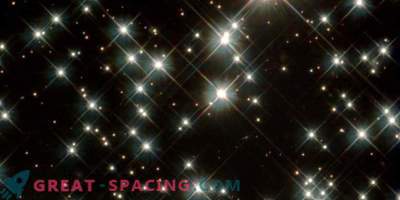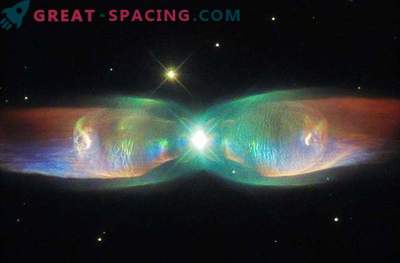
The concept of this artist shows a hypothetically “renewed” planet - a gas giant that “regained” itself youth, based on its infrared glow. NASA's Spitzer Space Telescope discovered preliminary facts showing such a glow in the atmosphere of a dead star satellite, or a white dwarf, called PG 0010 + 280 (shown as a white dot in the figure).
Perhaps astronomers have discovered an exoplanet, which received the effect of a kind of “elixir of life” for elderly inhabitants of the Universe, resulting in the removal of billions of years from their age.
Until now, the stellar “rejuvenation” was pure conjecture, but after studying the “white dwarf” called PG 0010 + 280, one very interesting conclusion was made: the detected excess of infrared radiation in the planet’s atmosphere “aged” may be similar to that accompanied her appearance.
“White dwarfs” are relict stars that have ceased to exist. At the end of the cycle, when a star like our Sun runs out of fuel, it degenerates into a “red giant,” plasma layers, which are carried into space by powerful streams of stellar winds. This creates a beautiful planetary nebula with a small, dense core called the “white dwarf”.
But what happens to all this material flying in space? Well, theoretically, some of them can fall on massive gas exoplanets orbiting a star and far away from it. Before this, the star was supposed to emerge from hydrogen and turn into a “red giant”, after which the exoplanet gradually grows old, slowly cooling for billions of years since its formation. However, the situation changes when its atmosphere becomes saturated with stellar plasma, and from re-heating the surrounding mass is made much younger than it actually is. “When the planets are young, they continue to glow with infrared light from their formation,” said Michael Yura of the University of California, Los Angeles, co-author of a study published in The Astrophysical Journal. "But as they get older and older, over time you cannot see it anymore. The newly regenerated planets will be visible again."
Studies of “white dwarfs” in recent years are being conducted more intensively, after astronomers realized that by studying the atmospheres of white dwarfs, one can find crushed remnants of asteroids and planetary bodies. When entering the white dwarf phase, the planets and asteroids that fall into orbit can drift too close to the powerful tidal forces near this star, and consequently become more crushed.
During a survey of white dwarfs in a chemical analysis of their crushed planetary remains, student Blake Pantoya, who was studying at the University of California at the time, came across something strange in the data from the broad NASA field. Infrared Survey Explorer and the subsequent study of the NASA Spitzer space telescope confirmed a strange excess of infrared radiation coming from PG 0010 + 280. At first, the team suggested an excess of ground asteroid residues emitted from the disk that may have been present - but the data did not agree with this explanation.
Thus, two explanations remain: it is possible that the excess is generated using a brown dwarf satellite (“failed” star) or from a potentially renewed planet heated by the influx of stellar matter. "I think the most exciting part of this study is that this infrared excess can potentially come from a giant planet, although you still have to work to prove it," said Xu Xu of the University of California. "If the version is confirmed, it will directly tell us that some planets can survive under the conditions of a star - a red giant and be present near white dwarfs."
To confirm whether this infrared excess is really the cause of the planet's renewal, astronomers urgently need the help of a new space telescope (which is scheduled to launch in 2018) according to James Webb, NASA. Although this assumption is tempting, we must wait for confirmation that this signal is actually not random.











































